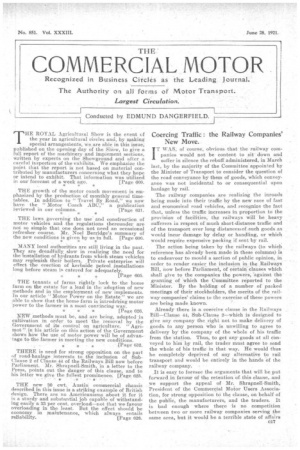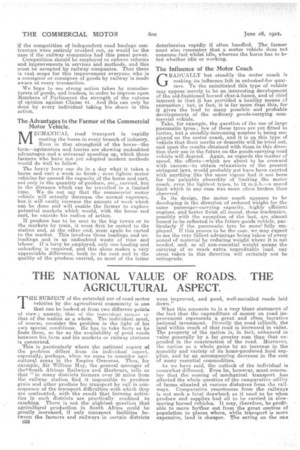Coercing Traffic : the Railway Companies' New Move.
Page 1

Page 2

If you've noticed an error in this article please click here to report it so we can fix it.
IT WAS, of course, obvious, that the railway companies would not be content to sit down and suffer in silence the rebuff administered, in March last, by the majority of the Committeeappointed by the Minister of Transport to consider the question of the road conveyance by them of goods, which conveyance was not incidental to or consequential upon haulage by rail: 'The railway companies are realizing the inroads being made into their traffic by the new race of fast and economical road vehicles, and recognize the fact that, unless the traffic increases in proportion to the provision of facilities, the railways will be heavy sufferers in respect of much short-distance traffic and Of the transport over long distanceslof -such goods as would incur damage by delay or handling, or which would require expensive packing if sent by rail.
The action being taken by the railways (to which reference has already been made in these columns) is to endeavour to mould a section of public opinion, in order to render easier the inclusion in the Railways Bill, now before Parliament, of certain clauses which shall give to the companies the powers, 'against the granting of which the Committee reported to the Minister. By the holding of a number of packed meetings of their stockholders, the merits of the railway companies' claims to the exercise of these powers are being made known. Already there is a coercive clause in the Railways Bill—Clause 44, Sub-Clause 2—which is designed to give any company the right not to make delivery of goods. to any person who is unwilling to agree to delivery by the company of the whole of his traffic from the station. Thus, to get any goods at all c-onveyed to him by rail, the trader must agree to send the whole of his traffic in that way. He would thus be completely deprived of any alternative to rail transport and would be entirely in the hands Of the railway company. It. is easy to foresee the arguments that will be :put forw.ardin favour of the retention of.this clause, and we support the appeal of Mr. Shrapnell-Smith, President of the Comthercial Motor Users Association, for strong opposition to the clause, on behalf of the public, the manufacturers, and the traders. It is bad enough where there is no competition between two or more railway companies serving the same area, but it would be a terrible state of affairs
if the competition of independent road haulage contractors were entirely crushed out, as would be the case if the railway companies had this penal power.
Competition should be employed to enforce reforms and improvements in services and methods, and this must be accepted by railway companies. That there is vast scope for this improvement everyone. who is a consignor or consignee of goods by railway is made aware at every transaction.
We hope to see strong action taken by manufacturers of goods, and traders, in order to impress upon Members of Parliament the strength of the volume of opinion against Clause 44. And this can only be done by every individual taking his share in this action.
The Advantages to the Farmer of the Commercial Motor Vehicle. The Advantages to the Farmer of the Commercial Motor Vehicle.
1\4 ECHANICAL road transport is rapidly ousting the horse in every branch of industry. Even in that stronghold of the horse—the farm—agrimotors and lorries are showing undoubted advantages and a universal speeding up, which those farmers who have not yet adopted modern methods would do well to follow.
The heavy lorry can do in a day what it takes a horse and cart a week to finish ; • even lighter motor vehicles far exceed the capacity of the horse and cart, not only in the quantity of produce, etc., carried, but in the distance which can be travelled in a limited time. We do not say that the commercial Motor vehicle will actually 'decrease the normal expenses, but it will vastly increase the amount of work which can be done and will enable the farmer to explore potential markets which would, with the horse and cart, be outside his radius of action.
If produce has to be sent to the big towns or to the markets by train, it must first be carted to the station and, at the other end, must again be carted to the market. This involves three loadings and unloadings and is an undoubted waste of time and labour. If a lorry be employed, only one loading and unloading is required, and this alone makes a very appreciable difference, both to the cost and to the quality of the produce carried, as most of the latter deteriorates rapidly if often handled. The farmer must also remember that a motor vehicle does not consume fuel whilst idle, whereas the horse has to be fed whether idle or working.
The Influence of the Motor Coach
-GRADUALLY but steadily the motor coach is
making its influence felt in unlooked-for quarters. To the uninitiated this type of vehicle may appear merely to be an interesting development of the old-fashioned horsed char-à-banes, and of chief interest in that it has provided a healthy means cf recreation ; but, in fact, it is far more than this, for it gives the lead to many possible and probable developments of the ordinary goods-carrying commercial vehicle.
Take, for example, the question of the use of large pneumatic tyres; few of these tyres are yet fitted to lorries, but a steadily-increasing number is being employed on the motor coach, and it is on this type of vehicle that their merits or demerits will be tried out, and upon the results obtained with them in this direction their use in the future on the goods-carrying road vehicle will depend. Again, as regards the matter of speed, the efforts—which are about to be crowned with success--to obtain relaxations of the present stringent laws, would probably not have been exerted with anything like the same vigour had it not been for the palpable absurdity of limiting the motor coach, even the lightest types, to 12 rrep.h.—a speed limit Which in any ease was more often broken than observed.
In its design, the motor coach appears to be developing in the direction of reduced weight for the same passenger-carrying capacity, highly efficient engines, and better finish all round, these tendencies, possibly with the exception of -the last, are almost bound to be reflected in the future goods vehicle, particularly if the pneumatic tyre be 1110r(?' fully employed. If this proves to be the case, we may expect to see the very fullest advantage being taken of every pound of material by reducing weight where it is not needed, and, as all non-essential weight means the carrying of so much extra unprofitable load, any steps taken in this direction will certainly not be retrograde.








































